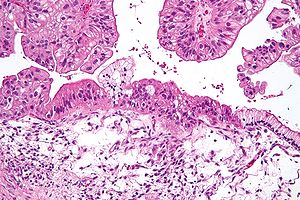
Ovarian cancer

Ovarian cancer is a cancer that forms in or on an ovary. It results in abnormal cells that have the ability to invade or spread to other parts of the body. When this process begins, there may be no or only vague symptoms. Symptoms become more noticeable as the cancer progresses. These symptoms may include bloating, pelvic pain, abdominal swelling, and loss of appetite, among others. Common areas to which the cancer may spread include the lining of the abdomen, lymph nodes, lungs, and liver.Ultrasound abnormalities:subdivisionStage 1 ovarian cancerStage 2 ovarian cancerStage 3 ovarian cancerStage 4 ovarian cancer Ovarian cancer is a cancer that forms in or on an ovary. It results in abnormal cells that have the ability to invade or spread to other parts of the body. When this process begins, there may be no or only vague symptoms. Symptoms become more noticeable as the cancer progresses. These symptoms may include bloating, pelvic pain, abdominal swelling, and loss of appetite, among others. Common areas to which the cancer may spread include the lining of the abdomen, lymph nodes, lungs, and liver. The risk of ovarian cancer increases in women who have ovulated more over their lifetime. This includes those who have never had children, those who begin ovulation at a younger age and those who reach menopause at an older age. Other risk factors include hormone therapy after menopause, fertility medication, and obesity. Factors that decrease risk include hormonal birth control, tubal ligation, and breast feeding. About 10% of cases are related to inherited genetic risk; women with mutations in the genes BRCA1 or BRCA2 have about a 50% chance of developing the disease. Ovarian carcinoma is the most common type of ovarian cancer, comprising more than 95% of cases. There are five main subtypes of ovarian carcinoma, of which high-grade serous carcinoma (HGSC) is the most common. These tumors are believed to start in the cells covering the ovaries, though some may form at the Fallopian tubes. Less common types of ovarian cancer include germ cell tumors and sex cord stromal tumors. A diagnosis of ovarian cancer is confirmed through a biopsy of tissue, usually removed during surgery. Screening is not recommended in women who are at average risk, as evidence does not support a reduction in death and the high rate of false positive tests may lead to unneeded surgery, which is accompanied by its own risks. Those at very high risk may have their ovaries removed as a preventive measure. If caught and treated in an early stage, ovarian cancer is often curable. Treatment usually includes some combination of surgery, radiation therapy, and chemotherapy. Outcomes depend on the extent of the disease, the subtype of cancer present, and other medical conditions. The overall five-year survival rate in the United States is 45%. Outcomes are worse in the developing world. In 2012, new cases occurred in approximately 239,000 women. In 2015 it was present in 1.2 million women and resulted in 161,100 deaths worldwide. Among women it is the seventh-most common cancer and the eighth-most common cause of death from cancer. The typical age of diagnosis is 63. Death from ovarian cancer is more common in North America and Europe than in Africa and Asia. Early signs and symptoms of ovarian cancer may be absent or subtle. In most cases, symptoms exist for several months before being recognized and diagnosed. Symptoms can be misdiagnosed as irritable bowel syndrome. The early stages of ovarian cancer tend to be painless. Symptoms can vary based on the subtype. Low malignant potential (LMP) tumors, also known as borderline tumors, do not cause an increase in CA125 levels and are not identifiable with an ultrasound. The typical symptoms of an LMP tumor can include abdominal distension or pelvic pain. Particularly large masses tend to be benign or borderline. The most typical symptoms of ovarian cancer include bloating, abdominal or pelvic pain or discomfort, back pain, irregular menstruation or postmenopausal vaginal bleeding, pain or bleeding after or during sexual intercourse, loss of appetite, fatigue, diarrhea, indigestion, heartburn, constipation, nausea, feeling full, and possibly urinary symptoms (including frequent urination and urgent urination). The growing mass may cause pain if ovarian torsion develops. Symptoms can be caused by a mass pressing on the other abdominopelvic organs or from metastases. If these symptoms start to occur more often or more severely than usual, especially after no significant history of such symptoms, ovarian cancer is considered. Metastases may cause a Sister Mary Joseph nodule. Rarely, teratomas can cause growing teratoma syndrome or peritoneal gliomatosis. Some experience menometrorrhagia and abnormal vaginal bleeding after menopause in most cases. Other common symptoms include hirsutism, abdominal pain, virilization, and an adnexal mass. In adolescents or children with ovarian tumors, symptoms can include severe abdominal pain, irritation of the peritoneum, or bleeding. Symptoms of sex cord-stromal tumors produce hormones that can affect the development of secondary sex characteristics. Sex cord-stromal tumors in prepubertal children may be manifested by early puberty; abdominal pain and distension are also common. Adolescents with sex cord-stromal tumors may experience amenorrhea. As the cancer becomes more advanced, it can cause an accumulation of fluid in the abdomen. If the malignancy has not been diagnosed by the time it causes ascites, it is typically diagnosed shortly thereafter. Advanced cancers can also cause abdominal masses, lymph node masses, or pleural effusion. Ovarian cancer is related to the amount of time spent ovulating. Thus not having children is a risk factor for ovarian cancer, likely because ovulation is suppressed via pregnancy. During ovulation, cells are constantly stimulated to divide while ovulatory cycles continue. Therefore, people who have not borne children are at twice the risk of ovarian cancer than those who have. A longer period of ovulation caused by early first menstruation and late menopause is also a risk factor. Both obesity and hormone replacement therapy also raise the risk.
